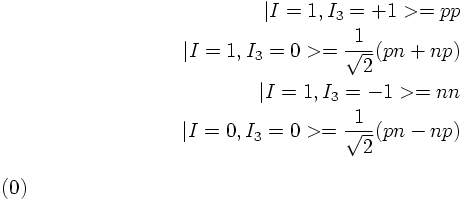The Dirac Equation
Introducing Spin
- The Stern-Gerlach experiment
- Spin vs. orbital angular momentum
- Connection to the Pauli-matrices
- Fields with internal degrees of freedom: Isospin and Colour
- Example of isospin conservation
ADDITION OF (ISO)SPINS
When adding two angular momenta or (iso)spins J1 and J2,
J = J1 + J2,
one can express the states |j1,j2;j m> in terms of the
basis |j1,j2; m1,m2>:
 where < j1,j2; m1,m2|j1,j2;j m>
are the Clebsch-Gordan coefficients.
where < j1,j2; m1,m2|j1,j2;j m>
are the Clebsch-Gordan coefficients.
The Clebsch-Gordan coefficients for several combinations can be found here:
PDG homepage: Clebsch-Gordan coefficients.
For a system of two nucleons the isospin states expressed in terms of the
nucleon isospins are given by

EXAMPLE FOR ISOSPIN CONSERVATION
If isospin is conserved in strong interactions one can predict e.g. the
following ratio of cross sesctions
 If one neglects the slightly different masses between the neutrons and protons,
and charged and neutral pions, respectively, the cross sections are
just given by isospin amplitudes squared:
If one neglects the slightly different masses between the neutrons and protons,
and charged and neutral pions, respectively, the cross sections are
just given by isospin amplitudes squared:
 With I(d)=0 and I(π)=1 and using isospin conservation the ratio is predicted to
be equal to 2.
With I(d)=0 and I(π)=1 and using isospin conservation the ratio is predicted to
be equal to 2.



